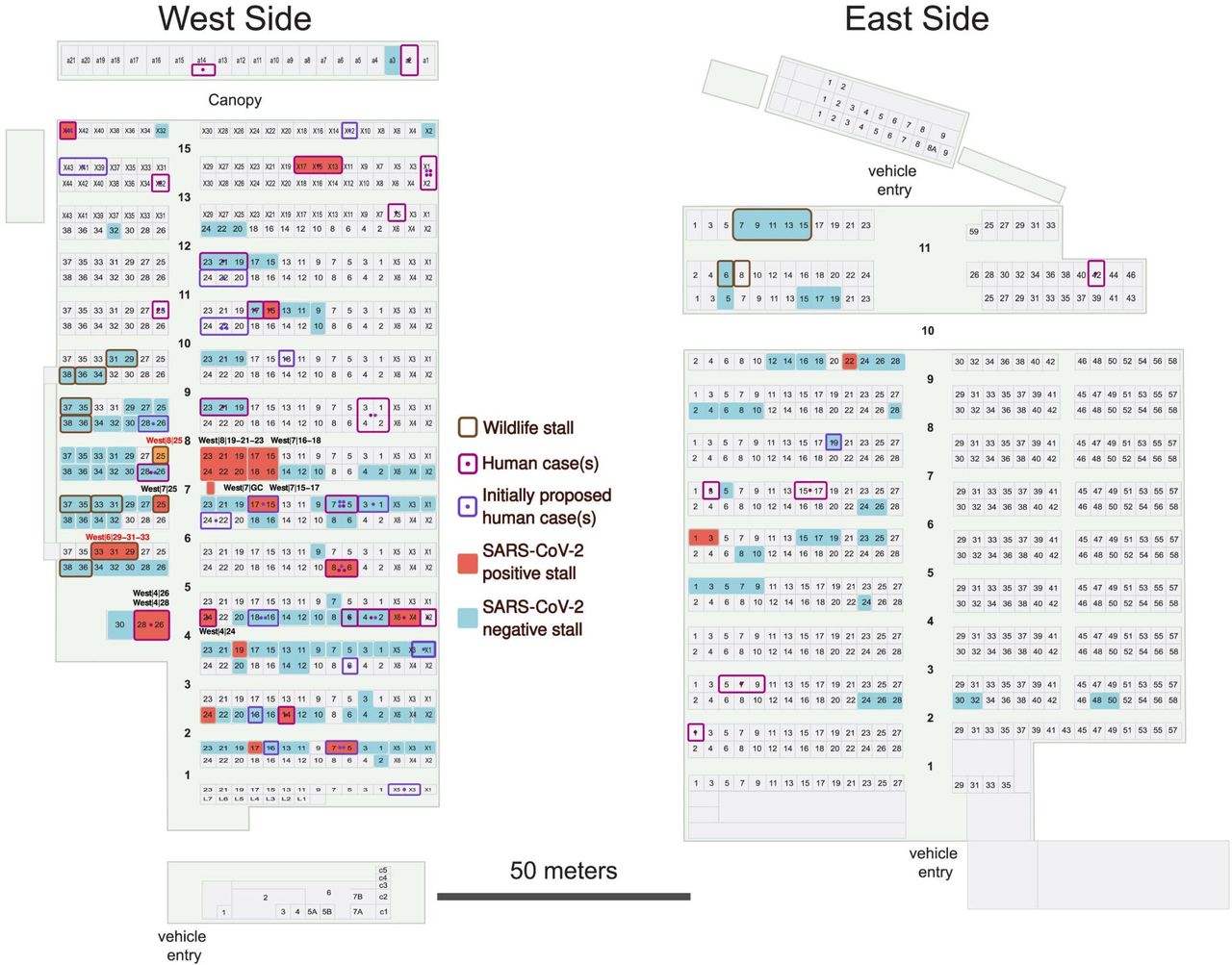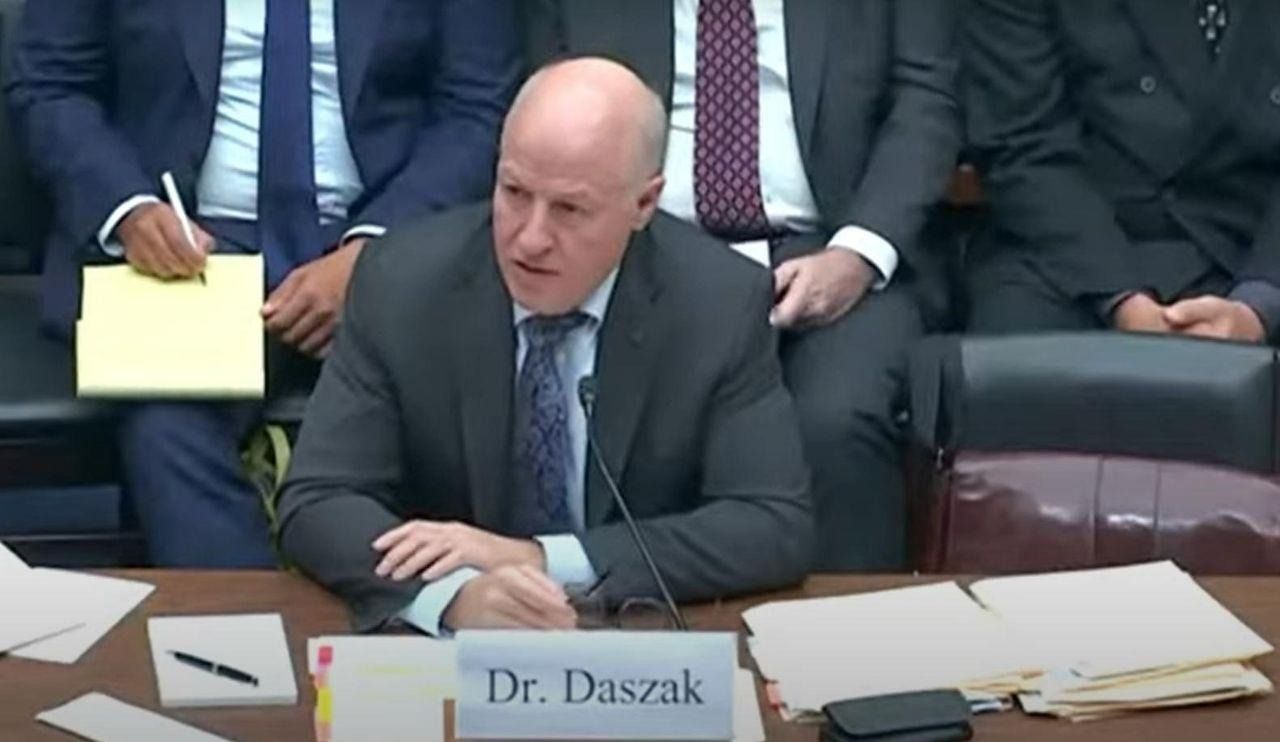Study by international researchers zeroes in on the natural origin of the COVID pandemic
Science has dealt another devastating blow to the far-right conspiracy theory that SARS-CoV-2, the virus which causes COVID-19, was created and then leaked from a Chinese government laboratory in the city of Wuhan.
A new study published in the journal Cell demonstrates not only the overwhelming evidence of the “zoonotic” (i.e., natural, rather than artificial) origin of the virus in wild animals sold in the Huanan Market in Wuhan. It actually puts the focus on a handful of animal species present at the market and even a specific numbered stall where the transfer from animals to humans likely took place.
The lengthy and detailed study was published this week by world-renowned researchers and investigators that include Edward C. Holmes, Robert F. Garry, Thomas P. Peacock, Andrew Rambaut, Angela L. Rasmussen, Joel O. Wertheim, Kristian G. Andersen, Michael Worobey and Florence Débarre. They have analyzed genetic material from more than 800 samples that had been previously been gathered at the Chinese market shortly after the outbreak was detected, to remarkable effect.
Utilizing more sophisticated and intricate genetic techniques than previous studies, the authors have now narrowed the list of probable animals present at the wet market that may have been infected with SARS-COV-2 and acted as the intermediate host that transmitted the as of then unknown bat coronavirus to humans. These include raccoon dogs, civet cats and bamboo rats. Study co-author Michael Worobey, an evolutionary biologist at the University of Arizona, explained that their findings will help investigators zero in on where the virus commonly circulates in animals. He said:
This may be the last big, new set of data directly from the market, and in a way, it’s like finishing the last piece of a puzzle showing a picture that has been pretty clear already. We present a thorough and rigorous analysis of the data and how it fits in with the rest of the huge body of evidence we have about how the pandemic started.
The origins of the present study
With respect to the data analyzed in this study, shortly after the wet market was closed on January 1, 2020, the Chinese CDC, led by Liu Jun, had sent teams into the buildings to collect samples. Although the animals had already been removed, they began swabbing the floors, walls, and surfaces of the numerous stalls. Several days later they returned to collect more samples from sections of the market where wildlife was sold or traded, specifically cages and carts that moved the animals, including the drains and sewers.
Over the course of the next several months, genetic sequencing of these samples led to the detection of SARS-CoV-2 from 74 environmental samples with three live viruses isolated. The results were eventually published in the journal Nature in April 2023. Although the species of animals involved were not identified, the Chinese CDC shared the sequencing data on public and open repositories.

At nearly the same time, Dr. Florence Débarre, a senior researcher at the National Center for Scientific Research in France and theoretician in evolutionary biology, identified among the trove of data the DNA sequences from a raccoon dog found together with the RNA from SARS-CoV-2.
In a report published in Zenodo on March 20, 2023, she and colleagues explained:
On March 4, 2023, we discovered accessions posted publicly on the GISAID database corresponding to sequences from environmental samples collected at the Huanan Seafood Wholesale Market, Wuhan. On March 9, we realized that those accessions were associated with raw metagenomic sequence read data files…
This data was consistent with the identity of the raccoon dog mixed with the genetic signature of the SARS-CoV-2 virus.
These wild animals were known to have been illegally sold at the market and were among the possible suspects for intermediary hosts for the virus, between bats and humans. However, the data that was posted on GISAID had not been part of the earlier dataset provided to the World Health Organization or other scientific bodies during the 2021 origin investigation and subsequent publication titled “Surveillance of SARS-CoV-2 in the environment and animal samples of the Huanan Seafood market.”
As Débarre noted about such scientific work:
Many of the key animal species had been cleared out before the Chinese CDC teams arrived, so we can’t have direct proof that the animals were infected. We are seeing the DNA and RNA ghosts of these animals in the environmental samples, and some are in stalls where SARS-CoV-2 was found, too. This is what you would expect under a scenario in which there were infected animals in the market.
More evidence of zoonotic origins of COVID
Additional supportive evidence for a zoonotic spillover was published by EcoHealth Alliance (EHA) and the Wuhan Institute of Virology (WIV) in August 2022 in Nature. They found high rates of infections with SARS-related coronaviruses across a large geographic swath that includes southern China, northeastern Myanmar, Laos and northern Vietnam. They estimated that around 66,000 people are infected with these pathogens every year.
EcoHealth’s leader, Dr. Peter Daszak, and other principled scientists have been maligned by both the Biden-Harris administration and the Republican-led House Select Subcommittee on the Coronavirus Pandemic. As the World Socialist Web Site remarked recently in response to the McCarthyite hearings held by the committee on the origins of COVID-19:
It has been estimated that around 300 million people in these regions are at risk, and that the wild animal live trade involved an estimated 14 million people as of 2016. Given these facts, a natural origin zoonotic spillover, rather than a handful of scientists working at a high-level security facility accidentally leaking the virus, is a far more likely explanation. Aside from the fact that all early cases centered around the Huanan market, there is no evidence that anyone at the WIV ever contracted COVID in this period. And had they, the epidemiological map would have been a far different one than has been revealed.

Dr. Michael Worobey, who has spoken eloquently on his work to refute the persistent fringe conspiracy theory, explained that when infected animals are brought into contact with dense human populations, it can make it easy for viruses that make the jump to take hold and begin an outbreak. “Not all of those viruses,” he said, “have the potential to start a pandemic, but when you do bring them in, it’s like a spark in a tinderbox.”
Dr. Holmes, an evolutionary biologist and virologist at the University of Sydney in Australia who had previously visited the Huanan wet market in 2014 and photographed a raccoon dog held behind the bars of an iron cage, said of the lab leak lie:
Although the laboratory leak allegation may at first seem appealing, particularly the coincidence of SARS-CoV-2 first appearing in a city with a large laboratory working on bat coronaviruses, closer inspection reveals that any supposed evidence for a lab leak is at best circumstantial.
Obvious evidence against the laboratory leak allegation is that the first documented cases of COVID-19 were not linked to the WIV nor in the same geographic region of Wuhan. The WIV laboratory of Professor Zhengli Shi, who has been the subject of abundant accusations because of her work on bat coronaviruses, is located more than 30 kilometers from the Huanan market epicenter. Clearly, if the virus first emerged at the WIV, then the location should be the site of at least some of the earliest cases or linked to those cases. It is not.
Findings of the genetic analysis
As the authors of the recent study noted, the market was the site where most of the wildlife vendors were illegally conducting their business. Several of them had been documented selling raccoon dogs, civets, bamboo rats, Malayan porcupines, and other species in late fall of 2019. More so, most of these vendors were working in the west wing of the market where the earliest and the majority of COVID infections occurred.
In addressing questions about the market as the origin of the pandemic, four near-complete samples of SARS-CoV-2, collected in the west wing, consisted of one from lineage A and three from lineage B, without mixture of the lineages. These two lineages were consistent with the two strains circulating during the initial phase of the outbreak in Wuhan in December 2019.
The authors wrote:
[That] the MRCA [Most Recent Common Ancestor] of SARS-CoV-2 linked to the Huanan market is equivalent to the MRCA of the pandemic establishes that the timing of the origin of the market outbreak is genetically indistinguishable from the timing of the origin of the pandemic as a whole. The presence of both lineages A and B at the market, and the spatial association of early lineage A cases with the market were results directly predicted under the hypothesis that SARS-CoV-2 first emerged in the human population at the Huanan market.
Furthermore, they found that the distribution of the positive SARS-COV-2 samples was concentrated in the southwest section of the market with clustering of the data across several stalls. Also, conducting specialized analysis looking for an abundance of animal mitochondrial DNA, five SARS-CoV-2 positive samples from wildlife stall labeled A contained DNA evidence of many animal species of which raccoon dogs, hoary bamboo rats, dogs and European rabbits were found, which are susceptible to SARS-CoV-2.

The scientists also set their sights on analyzing infections of the wild animals at Wuhan by other viruses to ascertain where these animals may have been brought from during their journey to the markets. The association between viral and even bacterial infections can distinguish the geographic region from which these animals were brought to Wuhan, and, by extension, narrow the location for the natural reservoir of the SARS-CoV-2.
The sequences identified samples from market animals that came from Sichuan and Guanxi. They wrote:
These findings suggest some movement of infected animals from southern China to Wuhan, a trade conduit that could have also led to the emergence of SARS-CoV-2. This result is also consistent with reports that Huanan market vendors sourced bamboo rats from Guangxi and Yunnan provinces. Movement of animal viruses such as these via the wildlife trade recapitulates the likely dispersal of SARS-CoV-1 from Yunnan to Guangdong and Hubei provinces.
A reconstruction of the mitochondrial genetic signatures from potential intermediate hosts, specifically the raccoon dog, for SARS-CoV-2 virus at the market and compared them to various subspecies of raccoon dogs known to extend from Vietnam to Russia. The data indicated that the raccoon dogs in Huanan were not from northern China and were genetically distinct from those raised on fur farms.
(Mitochondria are an important structure found in the cells of animals, plants, and fungi and function as the powerhouse generating needed energy and metabolic functions to keep the cell alive. They also possess their own DNA and can be used to trace animal ancestry.)
The researchers wrote, “These data are consistent with a geographic origin of the raccoon dogs in the Huanan market in central or southern China, from which a viral transmission chain within the animal trade could have arisen after a spillover from a bat reservoir south of Wuhan.”
In their discussion they summarized the evidence:
Multiple lines of evidence are consistent with the infection of wildlife animals with SARS-CoV-2 in the Huanan market. Animal carts, a cage, a garbage cart, and a hair/feather removal machine from a wildlife stall tested positive for SARS-CoV-2, and there was more DNA from mammalian wildlife species in these samples than human DNA. The surrounding stalls also had relatively higher rates of SARS-CoV-2 positivity, and drains adjacent to and downstream of this wildlife stall tested positive for SARS-CoV-2. Finally, there were several other viruses known to infect wildlife in these samples. These data indicate either that the animals present at this stall shed the SARS-CoV-2 detected on the animal equipment or that early unreported human case(s) of COVID-19 shed virus in the exact same location as the detected animals. Under a zoonotic scenario, viral shedding by infected animal handlers is expected to occur after shedding by the animals they were infected by. Therefore, human viral shedding post-zoonosis could plausibly also explain these data; in such a case, the animals brought into the stall are therefore still the most likely candidates for the zoonotic source. Although either animal or human viral shedding is consistent with these data, only a zoonotic origin of SARS-CoV-2 directly predicts co-detection of SARS-CoV-2 and wildlife genetic material.
The authors also recommended that investigators direct their future search for the origin to these regions where undersampling and concrete information is lacking. They continued:
Future studies to clarify the susceptibility status of all of these species using in vitro approaches and live-animal infection experiments, should also be prioritized. The limited viral and serological sampling of these species in Southeast Asia and southern China indicates that the wildlife trade directly before the COVID-19 pandemic is highly undersampled, or underreported. Retrospective studies should be performed, where possible, testing the species described here throughout the animal supply chains of Southeast Asia and southern China, through which in all scientific likelihood the COVID-19 pandemic emerged.
Conclusion
This exhaustive work only further confirms what has been previously reported, that a zoonotic spillover that threatens humanity was the cause of the COVID pandemic that has killed 30 million people and disabled hundreds of millions more.
Even as the data in this study was being analyzed, reactionary political forces have been going into motion to discredit the scientific investigation into COVID’s origins.

On May 1, 2024, there was a bipartisan inquisition of Dr. Peter Daszak, in which Democrats vied with Republicans to promote the conspiracy theory that SARS-CoV-2 was created with the support of the international non-profit research organization, EcoHealth Alliance, in a Chinese lab. It was nothing less than a show trial, to scapegoat Daszak and shift blame for the pandemic onto the Chinese government.
This claim originated with Donald Trump’s fascist adviser Steve Bannon and a Chinese multi-millionaire anti-communist. It has been embraced by “mainstream” media outlets like the New York Times and the Washington Post with pseudo-scientific demands that opponents of the lab leak “theory” provide irrefutable evidence of specific infected animals at the market.
These demands have been pressed despite the all-too-obvious fact that the proponents of the lab leak conspiracy have never offered any objective evidence of it. They completely ignore the ongoing investigations that have reaffirmed the zoonotic origin centered on the wet market and prefer to employ slanders and innuendos against scientists.
Philipp Markolin, whose exhaustive summary on the science behind the origin of COVID is essential reading, said of the attack on principled researchers, “The message is crystal clear. Speak up against us and our political myth making, and we will publicly smear and punish you with the power of the state.”
However, due to the tireless efforts by leading scientists to uncover the real origins of the pandemic, irrespective of the incessant attacks from reactionary forces on all fronts, attempts to present the lab leak lie as an incontrovertible fact have been, at least in the realm of scientific inquiry, thwarted.
The suggestion that lab leak conspiracy theories hold equal weight to the findings of actual science only underscores the extent to which imperialist war plans against China are driving the political agenda in Washington.
Precisely because of these geopolitical maneuvers to blame the pandemic on China, the pandemic as a trigger event is being used to infect the consciousness of the population to accept the basest lie as credible and turn science into fraud by maligning the scientists who continue to conduct this work. Such was the case with Kristian Andersen, who was attacked in 2023 by the House committee for his “origin” paper that established zoonosis as the most likely and plausible cause of the pandemic.
Dr. Andersen said recently about the present investigation, “Of any previous outbreak, pandemic, you name it, we don’t have this level of granularity. We can narrow it down to a single market and narrow it down to a section in that market, and maybe even narrow it to a single stall in that market. That is mind-boggling.” And one must add, very problematic for the agenda to use the pandemic as a selling point for war against China.
And precisely because science can uncover such necessary details, it has perturbed the powers in Washington who have set their task to label these scientists as malicious consumers of federal monies and call their work into question. The suspension of EcoHealth Alliance and calls for debarment are but a prelude to a broader imposition by the capitalist state on science and academia that demands conformity with the policy agenda of imperialism.


